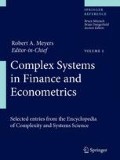Article Outline
Introduction
Economic Modeling Approaches
Methodological Issues
Conditions for Complexity
Complexity and the Role of Evidence
Future Directions
Bibliography
The remarks about neoclassical economics are drawn from my inaugural lecture [28]
Access this chapter
Tax calculation will be finalised at checkout
Purchases are for personal use only
Bibliography
Acemoglu D, Aghion P, Lelarge C, Van Reenen J, Zilibotti F (2007) Technology, information, and the decentralization of the firm. Q J Econ 122(4):1759–1799. http://www.mitpressjournals.org/doi/abs/10.1162/qjec.2007.122.4.1759
Adamic LA, Huberman BA (1999) Power-law distribution of the World Wide Web. Science 287(5461):2115
Alchian AA (1950) Uncertainty, evolution and economic theory. J Political Econ 58(2):211–221
Allais M (1953) Le comportement de l'homme rationnel devant le risque: Critiques des postulats et axiomes de l'ecole americaine. Econometrica 21(4):503–546
Anderson JR (1993) Rules of the mind. Lawrence Erlbaum Associates, Hillsdale
Bak P, Tang C, Weisenfeld K (1987) Self organized criticality: An explanation of 1/f noise. Phys Rev Lett 59(4):381–384
Bartel A, Ichniowski C, Shaw K (2007) How does information technology affect productivity? Plant-level comparisons of product innovation, process improvement, and worker skills. Q J Econ 122(4):1721–1758. http://www.mitpressjournals.org/doi/abs/10.1162/qjec.2007.122.4.1721
Barthelemy O (2006) Untangling scenario components with agent based modeling: An example of social simulations of water demand forecasts. Ph D thesis, Manchester Metropolitan University
Besley T, Preston I (2007) Electoral bias and policy choice: Theory and evidence. Q J Econ 122(4):1473–1510. http://www.mitpressjournals.org/doi/abs/10.1162/qjec.2007.122.4.1473
Brown R (1965) Social psychology. The Free Press, New York
Card D, Chetty R, Weber A (2007) Cash-on-hand and competing models of intertemporal behavior: New evidence from the labor market. Q J Econ 122(4):1511–1560. http://www.mitpressjournals.org/doi/abs/10.1162/qjec.2007.122.4.1511
Chandler AD (1962) Strategy and structure: Chapters in the history of the american industrial enterprise. MIT Press, Cambridge
Chandler AD (1977) The visible hand: The managerial revolution in american business. Harvard University Press
Coate S, Brian K (2007) Socially optimal districting: A theoretical and empirical exploration. Q J Econ 122(4):1409–1471
Downing TE, Moss S, Pahl Wostl C (2000) Understanding climate policy using participatory agent based social simulation. In: Moss S, Davidsson P (eds) Multi agent based social simulation. Lecture Notes in Artificial Intelligence, vol 1979. Springer, Berlin, pp 198–213
Eeckhout J (2004) Gibrat's law for (all) cities. Am Econ Rev 94(5):1429–1451
Friedman M (1953) The methodology of positive economics. In: Essays on Positive Economics. University of Chicago Press, Chicago
Granovetter M (1985) Economic action and social structure: The problem of embeddedness. Am J Sociol 91(3):481–510
Jacob BA, Lefgren L (2007) What do parents value in education? An empirical investigation of parents' revealed preferences for teachers. Q J Econ 122(4):1603–1637. http://www.mitpressjournals.org/doi/abs/10.1162/qjec.2007.122.4.1603
Jensen H (1998) Self-organized criticality: Emergent complex behavior in physical and biological systems. Cambridge University Press, Cambridge
Kahneman D, Tversky A (1979) Prospect theory: An analysis of decision under risk. Econometrica 47(2):263–292
Keynes JM (1935) The general theory of employment, interest and money. Macmillan, London
Knight FH (1921) Risk, uncertainty and profit. Houghton-Mifflin
Krugman P (1995) Development, geography and economic theory. MIT Press, Cambridge
Mandelbrot B (1963) The variation of certain speculative prices. J Bus 36(4):394–419
McFadzean D, Tesfatsion L (1999) A c++ platform for the evolution of trade networks. Comput Econ 14:109–134
Moss S (2001) Game theory: Limitations and an alternative. J Artif Soc and Soc Simul 4(2)
Moss S (1999) Relevance, realism and rigour: A third way for social and economic research. Technical Report 99-56, Centre for Policy Modeling, Manchester Metropolitan University
Moss S (2002) Policy analysis from first principles. Proc US Nat Acad Sci 99(Suppl. 3):7267–7274
Moss S, Edmonds B (2005) Towards good social science. J Artif Soc and Soc Simul 8(4). ISSN 1460-7425. http://jasss.soc.surrey.ac.uk/8/4/13.html
Moss S, Kuznetsova O (1996) Modeling the process of market emergence. In: Owsinski JW, Nahorski Z (eds) Modeling and analyzing economies in transition. MODEST, Warsaw, pp 125–138
Nelson RR, Winter SG (1982) An evolutionary theory of economic change. Harvard University Press, Cambridge
Nishiyama S, Smetters K (2007) Does social security privatization produce efficiency gains? Q J Econ 122(4):1677–1719. http://www.mitpressjournals.org/doi/abs/10.1162/qjec.2007.122.4.1677
Page SE, Tassier T (2007) Why chains beget chains: An ecological model of firm entry and exit and the evolution of market similarity. J Econ Dyn Control 31(10):3427–3458
Palmer R, Arthur WB, Holland JH, LeBaron B, Taylor P (1993) Artificial economic life: A simple model for a stock market. Physica D 75:264–274
Pareto V (1896–1897) Cours d'économie politique professé à l'Université de Lausanne. Rouge, Lausanne
Penrose ET (1959) The theory of the growth of the firm. Wiley, New York
Radner R (1968) Competitive equilibrium under uncertainty. Econometrica 36(1):31–58
Samuelson PA (1949) Foundations of economic analysis. Harvard University Press
Schweitzer F, Hoyst JA (2000) Modeling collective opinion formation by means of active Brownian particles. Europ Phys J B – Condens Matter Complex Syst 15(4):723–732
Simon HA, Bonini CP (1958) The size distribution of business firms. Am Econ Rev 48(4):607–617. ISSN 0002-8282 http://links.jstor.org/sici?sici=0002-8282%28195809%2948% 3A4%3C607%3ATS%D0BF%3E2.0.CO%3B2-3
Tesfatsion L (2001) Structure, behavior, and market power in an evolutionary labor market with adaptive search. J Econ Dyn Control 25(3–4):419–457
Zipf GK (1935) The psycho-biology of language. Houghton Mifflin, Boston
Zipf GK (1949) Human behavior and the principle of least effort. Addison-Wesley, Cambridge
Author information
Authors and Affiliations
Editor information
Editors and Affiliations
Rights and permissions
Copyright information
© 2009 Springer-Verlag
About this entry
Cite this entry
Moss, S. (2009). Agent Based Modeling and Neoclassical Economics: A Critical Perspective* . In: Meyers, R. (eds) Complex Systems in Finance and Econometrics. Springer, New York, NY. https://doi.org/10.1007/978-1-4419-7701-4_2
Download citation
DOI: https://doi.org/10.1007/978-1-4419-7701-4_2
Publisher Name: Springer, New York, NY
Print ISBN: 978-1-4419-7700-7
Online ISBN: 978-1-4419-7701-4
eBook Packages: Business and Economics

